In the ever-evolving world of digital marketing, understanding and effectively utilizing DoFollow links and NoFollow links can significantly enhance your SEO tactics and elevate your online presence. By mastering the balance between these two types of backlinks, you can refine your link-building strategies, improve your website’s authority, and drive organic traffic. This comprehensive guide will walk you through 10 powerful tactics to leverage these links for maximum SEO link optimization.
What Are DoFollow and NoFollow Links?
Before diving into tactics, let’s clarify the difference between DoFollow links and NoFollow links:
DoFollow Links
- Definition: These are links that pass on “link juice” or SEO value to the linked website, directly influencing its ranking on search engines. DoFollow links are very important.
- Purpose: Boosts domain authority, enhances visibility, and improves search engine rankings.
NoFollow Links
- Definition: These links include a rel=”nofollow” attribute, signaling search engines not to pass SEO value.
- Purpose: Used to prevent spamming or when a website does not want to endorse the linked content.
Both types of links are essential for a balanced SEO optimization strategy of links.
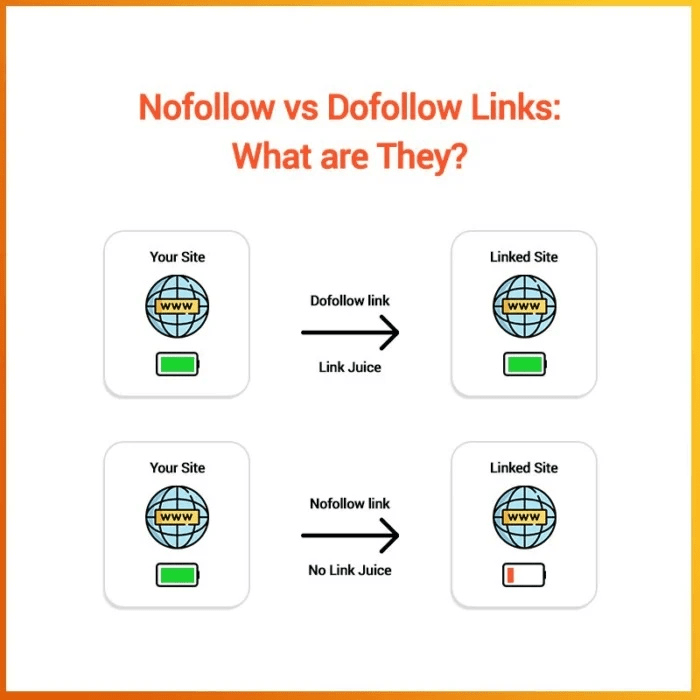
Why Are Backlinks Important for SEO?
Backlinks, whether DoFollow or NoFollow, play a critical role in determining your website’s credibility and ranking. Here are a few backlink best practices to keep in mind:
- High-quality backlinks from authoritative sites boost your SEO.
- Diversified backlinks signal a natural link profile to search engines.
- Proper use of anchor text helps improve keyword rankings.
10 Tactics to Master SEO with DoFollow & NoFollow Links
1. Analyze Your Existing Backlink Profile
To optimize your SEO performance, it is crucial to start by thoroughly analyzing your existing backlink profile. Here’s how to approach this step:
- Use SEO Tools: Tools like Ahrefs, SEMrush, and Moz provide detailed insights into your backlink structure and helps in marketing strategies. They help identify which links are DoFollow, NoFollow, or toxic.
- Evaluate Link Quality: Check the quality and authority of the sites linking to you which provides you DoFollow backlinks. Focus on high-authority websites that contribute positively to your rankings.
- Remove Toxic Links: Identify and disavow harmful or spammy backlinks that may trigger penalties from search engines.
- Check Link Diversity: Ensure your backlink profile includes a mix of DoFollow and NoFollow links to maintain a natural-looking profile.
Regular audits will help you maintain a healthy balance of backlinks and identify new opportunities for growth.
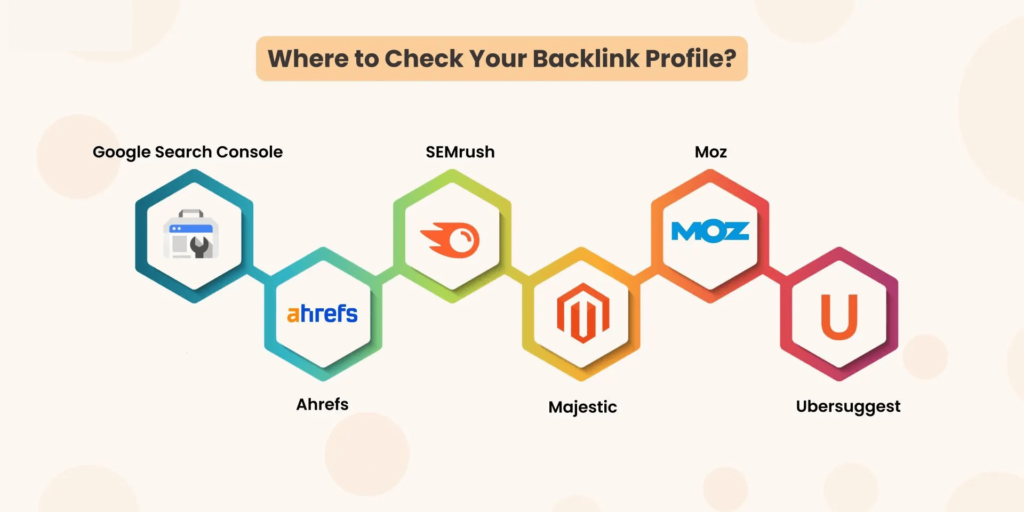
2. Create High-Quality, Shareable Content
Producing valuable, engaging content is a cornerstone of successful SEO and backlink building. High-quality content naturally attracts backlinks, including coveted DoFollow links. Here’s how to create shareable content:
- Focus on Originality: Develop unique, research-based articles, case studies, or guides that offer fresh insights.
- Use Visuals: Incorporate infographics, videos, and custom graphics to make your content more engaging and shareable.
- Solve Problems: Address common pain points or provide actionable solutions your audience is seeking.
- Write Comprehensive Guides: Long-form content with in-depth analysis tends to rank higher and attracts more backlinks.
Pro Tip:
Add an embedded link-sharing button to your content, encouraging others to link to it easily. High-quality content combined with strategic promotion is key to earning high-quality backlinks and enhancing your link-building strategies.
3. Guest Blogging on Authoritative Websites
Guest blogging is a powerful strategy for gaining high-quality backlinks either DoFollow or NoFollow while expanding your reach to new audiences. It is also important for social media marketing. By contributing content to reputable websites within your industry, you can build authority and establish credibility. Here’s how to make the most of guest blogging:
- Target Relevant Websites: Focus on websites that are authoritative in your niche and have a strong, engaged audience to get best DoFollow and NoFollow links.
- Create Value-Driven Content: Write informative, well-researched articles that offer value to the readers of the site you’re guest blogging on.
- Follow Guest Post Guidelines: Always adhere to the website’s submission guidelines to ensure your content is accepted and published to get best DoFollow and NoFollow links.
- Include Natural, Relevant Links: Incorporate backlinks to your own website in a natural and relevant way, ensuring they add value to the content.
- Engage with the Audience: Respond to comments and feedback on your guest post to build relationships with the readers and the website owner.
Pro Tip:
After publishing your guest post, share it across your social media channels to amplify its reach and increase the chances of gaining more backlinks. Guest blogging helps you leverage the authority of established websites to improve your SEO and expand your network.
4. Leverage NoFollow Links Strategically
While DoFollow links are often the primary focus in link-building strategies, NoFollow links still play a valuable role in driving traffic and boosting SEO. Here’s how to leverage NoFollow links to your advantage:
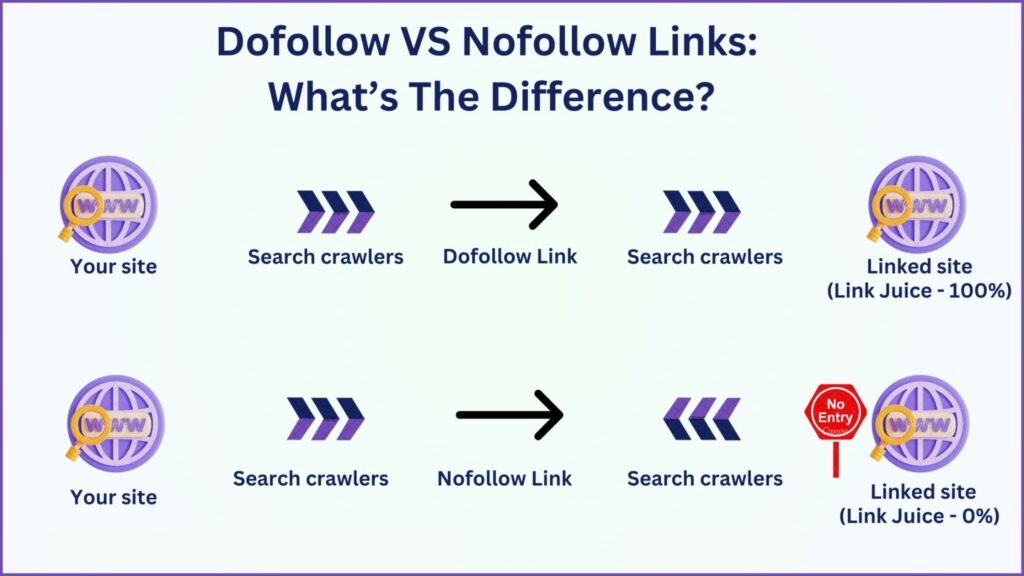
- Diversify Your Link Profile: A natural backlink profile includes a mix of DoFollow and NoFollow links. Relying solely on DoFollow links can appear manipulative to search engines.
- Increase Referral Traffic: NoFollow links can direct quality traffic to your website, especially when placed on high-traffic sites.
- Build Relationships and Trust: NoFollow links from authoritative websites or blogs can help build relationships and increase your brand’s visibility within your industry.
- Use in Social Media and Forums: NoFollow links are common in social media profiles, comments, and forums increasing social media marketing strategies. These links still bring users who are interested in your content and brand. However, DoFollow links are rarein this.
- Focus on Contextual Relevance: Even if a link is NoFollow, make sure it’s contextually relevant to the content and audience. This relevance enhances your overall visibility.
Pro Tip:
Don’t overlook NoFollow links—use them as part of a balanced strategy to diversify your link profile, attract referral traffic, and build genuine connections within your industry.
5. Build Relationships with Influencers
Collaborating with influencers is an effective way to enhance your backlink profile and increase your brand’s reach. By building genuine relationships with influencers, you can secure high-quality backlinks and amplify your content. Here’s how to do it:
- Identify Relevant Influencers: Focus on influencers in your niche who have a strong online presence and a loyal following.
- Engage on Social Media: Start by following and engaging with influencers on social media platforms. Share their content, comment thoughtfully, and participate in discussions to build rapport to get best DoFollow and NoFollow links.
- Offer Value: When reaching out, make sure to offer something of value in return. This could be a guest post opportunity, product collaborations, or valuable content that aligns with their audience’s interests.
- Collaborate on Content: Work with influencers to co-create content such as blog posts, videos, or infographics. This not only earns backlinks but also exposes your brand to a broader audience.
- Be Authentic and Transparent: Build long-term, genuine relationships with influencers by being authentic in your outreach and communication to get best DoFollow and NoFollow links.
Pro Tip:
Focus on building ongoing partnerships with influencers instead of one-off collaborations. Long-term relationships can lead to multiple backlinks and sustained brand growth.
6. Optimize Anchor Text
Optimizing anchor text is a crucial aspect of link-building and SEO. The right anchor text can improve both the relevance of your backlinks and your website’s ranking on search engines. Here’s how to optimize anchor text effectively:
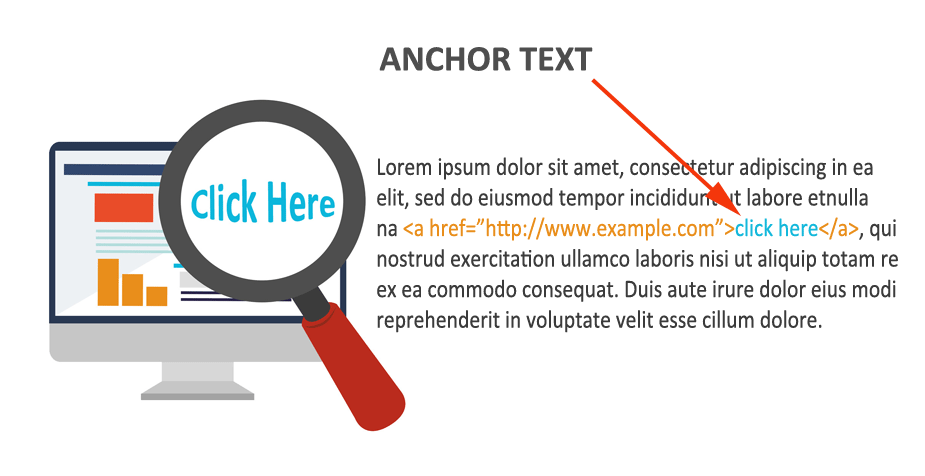
- Use Descriptive Anchor Text: Make sure your anchor text clearly describes the content users will find when they click the link. This helps search engines understand the context of the linked page.
- Incorporate Relevant Keywords: Use keywords that are closely related to the content of the linked page. However, avoid over-optimization or keyword stuffing, as it can be penalized by search engines. For example, in a e-commerce website if you are selling headphones, the keywords can be ‘beats headphones’ etc.
- Diversify Anchor Text: Don’t use the same anchor text repeatedly. Mix up branded terms, exact match keywords, partial match keywords, and generic phrases like “click here” to create a natural link profile.
- Prioritize Contextual Relevance: Ensure that the anchor text is relevant to the surrounding content. Links embedded within informative, contextually relevant text are more likely to be trusted by search engines.
- Use Internal Linking Wisely: Optimize your internal links by using descriptive, keyword-rich anchor text that helps users and search engines navigate your site more effectively.
Pro Tip:
Regularly audit your anchor text strategy to maintain a healthy link profile and avoid overuse of any specific keyword. A diverse, well-optimized anchor text strategy contributes significantly to your website’s SEO performance.
7. Repurpose Content Across Channels
Repurposing content across multiple channels is a smart way to extend the lifespan of your content while reaching a broader audience and AI chatbot can be used for this purpose. By adapting your existing content to different formats, you can attract more backlinks and increase engagement. Here’s how to do it effectively:
- Turn Blog Posts into Infographics: Convert detailed blog posts into visually appealing infographics that are more shareable on social media and other platforms to get best DoFollow and NoFollow links.
- Create Videos from Written Content: Repurpose long-form articles into video content or tutorials for platforms like YouTube or social media, expanding your reach and encouraging backlinks.
- Leverage Social Media Posts: Break down key points from blog posts or guides into bite-sized posts for Twitter, Instagram, or LinkedIn, prompting shares and backlinks from followers.
- Transform Case Studies into Presentations: Turn detailed case studies into slide decks and share them on platforms like SlideShare to attract backlinks and new audiences.
- Use Podcasts or Webinars: Host podcasts or webinars where you discuss the content in-depth, allowing listeners to link back to your website for more resources.
Pro Tip:
Repurposing content across various channels not only extends its reach but also increases the chances of getting backlinks from different audiences. Focus on creating content that’s adaptable and can be tailored to suit different formats.
8. Participate in Online Communities
Engaging with online communities is a powerful way to build relationships, share your expertise, and earn backlinks. By actively participating in forums, groups, and discussions, you can establish your authority and direct traffic to your site. Here’s how to get involved effectively:
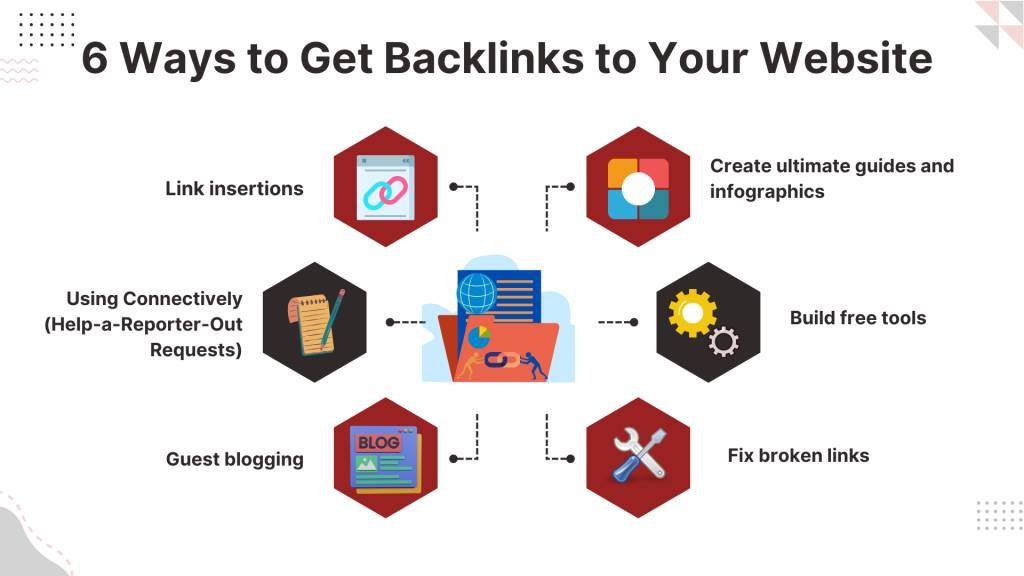
- Join Relevant Communities: Participate in forums, social media groups, and niche-specific communities like Reddit, Quora, or specialized industry forums where your target audience hangs out.
- Contribute Valuable Insights: Offer thoughtful, helpful responses to questions or discussions. Share your expertise and link to your content when it adds value to the conversation.
- Be Active and Consistent: Regularly engage with community members by commenting, answering questions, or sharing resources. Consistency builds your reputation and trust within the community.
- Avoid Spammy Behavior: Focus on genuinely contributing to the community rather than solely promoting your website. Spammy behavior can damage your reputation and lead to being banned and focus on content writing.
- Leverage Signature Links: Many online communities allow you to include a signature or profile link. Use this to subtly link back to your site without being overly promotional.
Pro Tip:
Build relationships within these communities before dropping links. The more you contribute genuinely, the more likely community members will click on and share your content, earning you valuable backlinks.
9. Conduct Broken Link Building
Broken link building is a highly effective strategy for acquiring backlinks by identifying broken links on authoritative websites like WordPress and offering your own content as a replacement. This approach helps both you and the website owner by improving the user experience and enhancing their site’s SEO. Here’s how to implement broken link building:
- Find Broken Links: Use tools like Ahrefs, Screaming Frog, or Check My Links to identify broken links on high-authority websites within your niche.
- Create Relevant Content: Ensure you have high-quality, relevant content that can replace the broken links. The content should provide similar value or insights to the original linked resource.
- Reach Out to Website Owners: Contact the website owners or webmasters, informing them about the broken link and suggesting your content as a suitable replacement. Be polite and helpful in your outreach.
- Personalize Your Emails: Craft personalized emails to increase the chances of a response. Highlight how your content can benefit their readers and improve their site’s user experience.
- Monitor Success: Keep track of your outreach efforts and follow up with webmasters who haven’t responded. Monitor the success of your link placements.
Pro Tip:
Broken link building works best when you target high-authority sites and offer genuinely valuable content as a replacement. This strategy helps you earn quality backlinks while providing a helpful service to site owners.
10. Monitor Competitors’ Backlinks
Tracking your competitors’ backlinks is an essential strategy for uncovering new link-building opportunities and understanding what’s working in your industry. By analyzing where your competitors are getting their backlinks, you can identify gaps and replicate successful tactics. Here’s how to monitor and leverage competitors’ backlinks effectively:
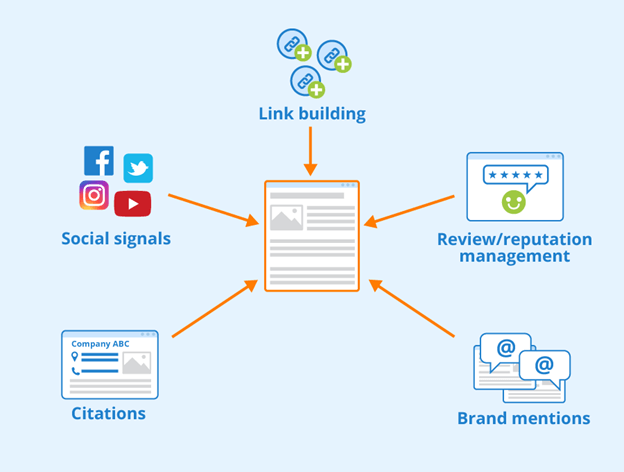
- Use Backlink Analysis Tools: Tools like Ahrefs, SEMrush, or Moz can help you track your competitors’ backlinks and identify which sites are linking to them.
- Identify High-Quality Links: Focus on backlinks from authoritative websites in your niche as Shopify in e-commerce. These are the kinds of links you should target for your own link-building efforts.
- Look for Untapped Opportunities: Pay attention to the types of sites linking to your competitors that you haven’t yet targeted. This could include industry blogs, media outlets, or directories.
- Replicate Successful Strategies: If a competitor is getting links from guest posts, collaborations, or specific content types, consider incorporating similar tactics into your own strategy.
- Monitor New Backlinks Regularly: Keep track of new backlinks your competitors acquire so you can quickly act on any new opportunities to secure similar links.
Pro Tip:
Monitoring your competitors’ backlinks allows you to stay ahead of the curve and capitalize on new link-building opportunities. Use this strategy to strengthen your own SEO efforts and build relationships with high-authority sites.
Balancing DoFollow and NoFollow Links
A healthy backlink profile includes both DoFollow and NoFollow links. Aim for:
- 70-80% DoFollow links for SEO value.
- 20-30% NoFollow links for traffic and diversity.
Key Takeaways:
- Prioritize quality over quantity.
- Avoid black-hat techniques like buying backlinks.
- Maintain a natural and diverse link profile.
The Role of Internal Links in SEO
Don’t overlook the power of internal links for SEO ranking improvement. Proper internal linking:
- Helps distribute link juice across your website.
- Improves user experience by guiding visitors to relevant content.
- Increases the time users spend on your site, signaling quality to search engines.
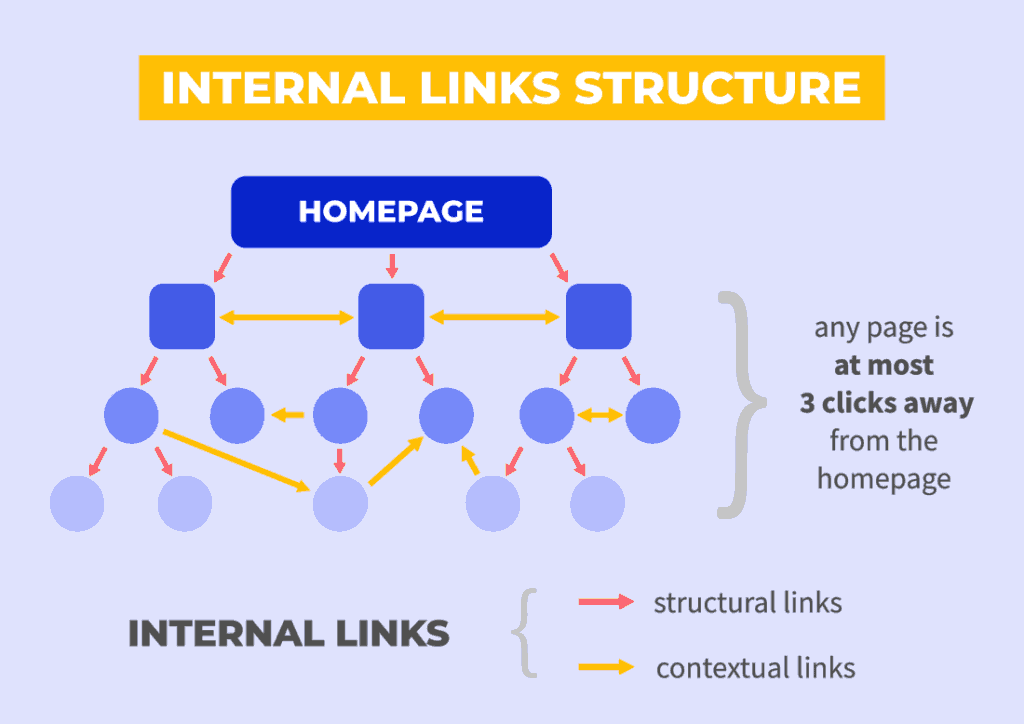
Tools to Simplify Link-Building Strategies
Here are some tools to enhance your link-building strategies:
- Ahrefs: For backlink analysis and competitor research.
- SEMrush: Comprehensive SEO toolkit.
- Moz Link Explorer: Evaluate your domain authority and backlinks.
- BuzzStream: Streamline outreach campaigns.
- Google Search Console: Monitor your link performance.
FAQs
- What is the importance of backlinks for SEO?
Backlinks improve your website’s authority and search engine ranking by signaling trust to search engines. - What is the difference between DoFollow and NoFollow links?
DoFollow links pass SEO value and help rankings, while NoFollow links don’t directly impact SEO but still drive traffic. - How can I build high-quality backlinks?
Focus on creating valuable content, guest blogging, and networking with influencers to earn high-quality backlinks. - Why should I focus on anchor text optimization?
Optimizing anchor text ensures that links are relevant and help improve the ranking of the linked page. - What is broken link building?
It involves finding broken links on websites and suggesting your own content as a replacement for a backlink. - How can I track my competitors’ backlinks?
Use backlink analysis tools like Ahrefs or SEMrush to monitor and replicate your competitors’ link-building strategies.
Conclusion
Mastering DoFollow links and NoFollow links is an essential skill for anyone looking to improve their website’s performance. By implementing these 10 SEO tactics, you’ll not only build a robust backlink profile but also enhance your overall SEO link optimization. Remember, consistency and a focus on quality are key to achieving long-term success in the competitive world of digital marketing and it is also important for the e-commerce sites.
Ready to take your SEO to the next level? Explore more search engine optimization tips and services at DigitalErena to transform your online presence today!

Pingback: Why Google Keyword Planner is Essential for SEO in 2025
Pingback: Beheers SEO met Dofollow en Nofollow Links - DigitalErena.nl
Pingback: Supercharge Your Non-Profit NGO’s Impact: The Power of SEO!
Your point of view caught my eye and was very interesting. Thanks. I have a question for you.
Can you be more specific about the content of your article? After reading it, I still have some doubts. Hope you can help me.